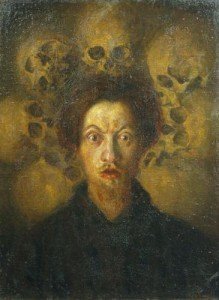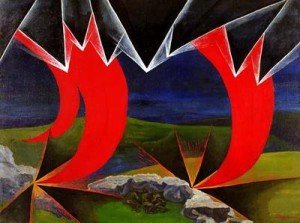News
Russolo’s Art of Noises at the Estorick
Luigi Russolo was one of the most original personalities of Futurism – of which he was both a founder and a theorist – and this is the first major retrospective exhibition of his work.

Luigi Russolo: Life and Works of a Futurist, on view at the Estorick Collection of Modern Italian Art, 39a Canonbury Square, London N1, from Wednesday 4 October to Sunday 17 December 2006, is an exhibition of noise-intoners, paintings, engravings and archive material by this outstanding Futurist artist.
By selecting, co-ordinating and dominating all noises, we will enrich men with a new and unexpected sensual pleasure : the art of noises. (Luigi Russolo, ‘The Art of Noises’, Lacerba, 1913)
As well as being one of the earliest composers and the genius of Futurist music, Luigi Russolo (1885-1947) was also an instrument builder, a signatory of the ‘Manifesto of Futurist Painters’, an engraver, a mystic and a scholar of Oriental philosophy. He was one of the most original personalities of Futurism – of which he was both a founder and a theorist – and this is the first major retrospective exhibition of his work.
The exhibition, organised by the Museo d’Arte Moderna e Contemporanea di Trento e Rovereto (MART) and the Estorick Collection, explores his artistic development. Russolo’s noise-intoners – created by the artist to ‘harmoniously and rhythmically intone and regulate’ noises – have been specially reconstructed for the exhibition, and the public will be invited to interact with them. The exhibition also features his complete output of engravings, alongside a selection of his Futurist and pre-Futurist paintings and works by his closest artistic associates: Gaetano Previati, Umberto Boccioni, Carlo Carrà, Gino Severini, Romolo Romani and Ugo Piatti.
The Art of Noises

Russolo’s spectacular, experimental sound-making machines – called noise-intoners, and used for concerts and performances – were born out of the ideas first put forward in his manifesto ‘The Art of Noises’ (1913). In this, written as an open letter to the Futurist musician Balilla Pratella, the artist stated that his aim was not the creation of cacophonous sound, but rather a rigorous research into acoustics and harmony – the discipline he was proposing to renew. Russolo wrote to Pratella: ‘Acoustics has little to teach us as it has – up to now – been applied primarily to the study of pure sound, neglecting almost entirely the study of noises.’ Hence the need for a set of instruments conceived to produce explosions, crackles, buzzes and scrapes. During his time in Paris between 1928 and 1930, Russolo expanded the range of applications for his noise-making inventions to include avant-garde cinematography. At this time, he was a regular frequenter of the circles of avant-garde cinema and played his instruments – the noise-intoners and the Russolophone – at the cinema Studio 28. Three such films, The March of the Machines, Electric Nights and Montparnasse (edited by Carlo Montanaro especially for this exhibition) will be included in the show, with a musical accompaniment directed by Daniele Lombardi.
Russolo’s noise-intoners, reconstructed by Pietro Velardo especially for the exhibition, will also be exhibited. In a number of cases, the accuracy of their reconstruction (compared to last century’s reconstructions) has been greatly improved by using recently uncovered documentation. Visitors will be invited to play the noise intoners and encouraged to interact with the exhibits.
Russolo and the Futurists in Europe
The Futurist exhibition of 1912 at the Galerie Bernheim-Jeune was, for Russolo, the beginning of a veritable European ‘grand tour’ that would make him famous in London, Brussels, The Hague, Amsterdam, Munich and Budapest, along with Boccioni and Carrà, with whom two years earlier Russolo had written the ‘Manifesto of the Futurist Painters’ and the ‘Technical Manifesto’ of Futurist painting. Similarly, in Rome the following year, Russolo exhibited his most important Futurist works on canvas to date: Music (1911), The Revolt (1911), Solidity of Fog (1912), Interpenetration of Houses + Light + Sky (1912) and Simultaneous Movements of a Woman (1912), with the addition of a number of interesting self portraits. The exhibition includes several key works by Russolo’s fellow Futurists which were also shown in Rome in 1913, such as Boccioni’s Modern Idol (1911), Carrà’s What the Tram told Me (1911) and Severini’s The Boulevard (1910-11).
From the 1920s to the 1940s
Throughout the Twenties, Russolo aligned himself with the spirit of renewal characteristic of that decade’s painting. In the great Futurist exhibition of 1919 at the former Caffè Cova, Russolo showed works dated prior to 1913 and gave a successful noise-intoners concert and conference on his music. In 1920 Russolo was the (probable) sole author of the Futurist manifesto ‘Against all Returns in Painting’, which was also signed by Dudreville, Funi and Sironi. That same year, in Milan, Margherita Sarfatti organised the collective exhibition that effectively anticipated the formation of the Novecento Italiano group. To this exhibition, Russolo contributed the ‘well defined’ Portrait of a Woman.
This retrospective is based on Russolo’s substantial archive, the conservation of which has been entrusted to MART’s twentieth-century documentation archive. Using this material as their starting point, the exhibition curators Anna Gasparotto and Franco Tagliapietra have mapped out Russolo’s creative development, dividing the exhibition into six thematic sections: the artist’s relation to the Symbolist and Divisionist painters of Lombardy; his engraved and pictorial output, from pre-Futurism to Futurism proper; his musical activities; his post-Futurist pictorial production; his Parisian and Spanish periods and his return to Lombardy. Towards the end of the exhibition a hypothesis is proposed, grounded in Russolo’s literary and philosophical reflections, as to what may have brought about his last prolific pictorial period from the early 1940s until his death in 1947, defined by the artist as his ‘modern classicism’ phase. Russolo’s final works, consisting mainly of figurative paintings and drawings, reflect the quiet stillness of this artist and philosopher’s now pacified soul. This period is represented by works such as Reflections and Romantic Landscape (both 1944).

Fact Sheet
Title: Luigi Russolo: Life and Works of a Futurist
Dates: 4 October to 17 December 2006
Organised by: Museo d’Arte Moderna e Contemporanea di Trento e Rovereto (MART) and the Estorick Collection
Curators: Anna Gasparotto and Franco Tagliapietra
Location: Estorick Collection of Modern Italian Art
39a Canonbury Square, London N1 2AN
Tel. 020 7704 9522, Fax. 020 7704 9531, www.estorickcollection.com
Opening hours: Wednesday
to Saturday 11.00 – 18.00 hours, Sunday 12.00 – 17.00 hours
Shop: open gallery hours. Library: by appointment only
Admission: £3.50, concessions £2.50. Free to under-16s and students on production of a valid NUS card. Library, by appointment only, £2.50 per visit.
Groups: Groups of 10 or more may book gallery talks by curatorial staff on the current exhibition and the permanent collection. Talks last for approximately 50 minutes and there is an additional charge of £3.50 per head. Lunch can also be arranged for groups.
Catalogue: The exhibition is accompanied by a fully-illustrated catalogue published by Skira.
Events: There will be series of gallery talks, free with admission ticket on the day.
The Big Draw ‘Moving Statues’
Drop in workshop
Sunday 15 October 2006, 14:00 – 16:00
Free with an admission ticket
Suitable for all ages
Learn how to use quick sketching techniques to show movement of the human figure in this fun family workshop. Materials provided or bring your favourite sketchbook.
Late night opening
Events Held in Connection with the Exhibition
Luigi Russolo: Life and Works of a Futurist, 4 October to 17 December 2006
Late night opening
Friday 27 October, 18:00 – 21:30
In conjunction with local visual arts venues Rollo Contemporary Art and Florence Trust Studios, the Estorick Collection and café will be open late for one night only.
Sound Alert by Brown Sierra
Tuesday 14 November, 18:00 – 20:30
Performance at 19:00
£8/£6 members and concessions
The Sound Alert orchestra consists of doorbells, car horns, bicycle bells and alarms, some of which have been adapted electronically, to create a fascinating urban soundscape performance. Ticket includes a glass of wine, entrance to the museum and the performance. Please book in advance on 020 7704 9522.
Gallery Talks – Saturday afternoons at 15.00
Informal talks on aspects of the exhibition last approximately 40 minutes and are free with an admission ticket purchased on the day.
Saturday 21 October
Painter and noise-maker
Lutz Becker, Film-maker and curator
Saturday 4 November
Silent Noise: Consciousness, Colour, and Sound
Gary Lachman, Musician and journalist
Saturday 18 November
Russolo’s Futurist Ear
James Hayward, from the archive label, LTM Recordings
Saturday 2 December
Russolo and Printmaking
Christopher Adams, Estorick Collection















